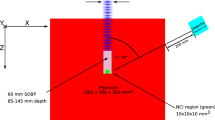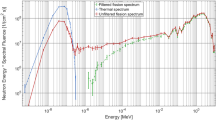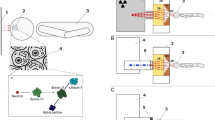Abstract
THE danger of neutrons on the human body arises from two factors : the slowing down of fast neutrons and the absorption of neutrons. In the case of thermal neutrons, only absorption can take place, either in hydrogen to form a deuteron with emission of a 2.2-MeV. γ-ray, or by nitrogen-14 to form a carbon, with the emission of a 0.7-MeV. proton. In a very complete paper on the subject, Mitchell1 finds that the ionization produced in the human body can be attributed half to the γ-rays of the latter reaction and half to the protons. This note deals only with the γ-rays from the H(n,γ)D reaction.
This is a preview of subscription content, access via your institution
Access options
Subscribe to this journal
Receive 51 print issues and online access
$199.00 per year
only $3.90 per issue
Buy this article
- Purchase on SpringerLink
- Instant access to full article PDF
Prices may be subject to local taxes which are calculated during checkout
Similar content being viewed by others
References
Mitchell, Brit. J. Rad. (Feb. 1947).
Fermi and Amaldi, Phys. Rev., 50, 899 (1936).
Author information
Authors and Affiliations
Rights and permissions
About this article
Cite this article
CAPRON, P., FAES, M. & TAVERNIER, G. Tolerance Flux of Thermal Neutrons. Nature 163, 129 (1949). https://doi.org/10.1038/163129a0
Issue date:
DOI: https://doi.org/10.1038/163129a0
This article is cited by
-
The neutron tissue dose
The Soviet Journal of Atomic Energy (1961)
-
Thermal Neutron Distribution in a Slab of Paraffin
Nature (1950)



